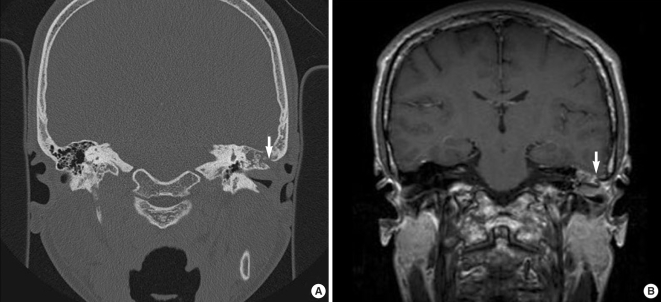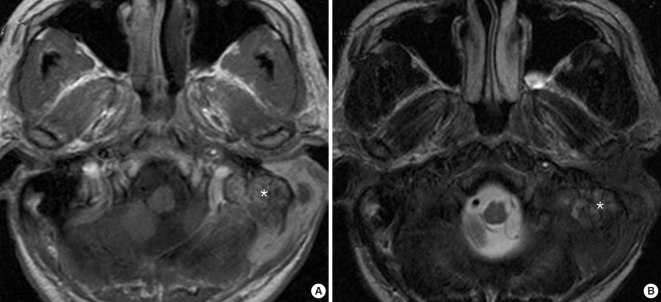Clin Exp Otorhinolaryngol.
2009 Dec;2(4):198-202. 10.3342/ceo.2009.2.4.198.
Temporal Bone Myeloid Sarcoma
- Affiliations
-
- 1Department of Otorhinolaryngology, The Catholic University of Korea School of Medicine, Seoul, Korea. khchang@catholic.ac.kr
- KMID: 1466498
- DOI: http://doi.org/10.3342/ceo.2009.2.4.198
Abstract
- Myeloid sarcoma is a rare condition that's caused by the aggregation of immature myeloid cells in leukemic patients. Myeloid sarcoma occurring in the temporal bone more frequently involves the mastoid bone than is the case for metastatic lesions arising from non-systemic malignancies. The disease is difficult to diagnose when it presents with symptoms that mimic otomastoiditis. However, an early diagnosis is important in order to achieve complete remission of the disease. Magnetic resonance imaging of the temporal bone is useful for making the diagnosis of myeloid sarcoma, and especially to evaluate the extent of disease. High-dose radio- or chemotherapies are the first-line approaches and possibly the only approaches to achieve complete remission and to cure the disease. With the aim of improving our understanding of myeloid sarcoma in the temporal bone, the present report describes our experience with 5 such cases and we compare the clinical features of these 5 patients with those clinical features of patients who have metastatic lesions.
Keyword
MeSH Terms
Figure
Reference
-
1. Cureoglu S, Tulunay O, Ferlito A, Schachern PA, Paparella MM, Rinaldo A. Otologic manifestations of metastatic tumors to the temporal bone. Acta Otolaryngol. 2004; 12. 124(10):1117–1123. PMID: 15768802.
Article2. Almadori G, Del Ninno M, Cadoni G, Di Mario A, Ottaviani F. Facial nerve paralysis in acute otomastoiditis as presenting symptom of FAB M2, T8;21 leukemic relapse: case report and review of the literature. Int J Pediatr Otorhinolaryngol. 1996; 6. 36(1):45–52. PMID: 8803691.
Article3. Berlinger NT, Koutroupas S, Adams G, Maisel R. Patterns of involvement of the temporal bone in metastatic and systemic malignancy. Laryngoscope. 1980; 4. 90(4):619–627. PMID: 7359981.
Article4. Paparella MM, Berlinger NT, Oda M, el-Fiky F. Otological manifestations of leukemia. Laryngoscope. 1973; 9. 83(9):1510–1526. PMID: 4519018.
Article5. Pileri SA, Ascani S, Cox MC, Campidelli C, Bacci F, Piccioli M, et al. Myeloid sarcoma: clinico-pathologic, phenotypic and cytogenic analysis of 92 adult patients. Leukemia. 2007; 2. 21(2):340–350. PMID: 17170724.6. Paydas S, Zorludemir S, Ergin M. Granulocytic sarcoma: 32 cases and review of the literature. Leuk Lymphoma. 2006; 12. 47(12):2527–2541. PMID: 17169797.
Article7. Devaney KO, Boschman CR, Willard SC, Ferlito A, Rinaldo A. Tumours of the external ear and temporal bone. Lancet Oncol. 2005; 6. 6(6):411–420. PMID: 15925819.
Article8. Gloria-Cruz TI, Schachern PA, Paparella MM, Adams GL, Fulton SE. Metastases to temporal bones from primary nonsystemic malignant neoplasms. Arch Otolaryngol Head Neck Surg. 2000; 2. 126(2):209–214. PMID: 10680873.
Article9. Thompson DH, Ross DG, Reid JW. Granulocytic sarcoma (chloroma) initially seen as acute mastoiditis. Arch Otolaryngol. 1982; 6. 108(6):388–391. PMID: 6953953.
Article10. Tsimberidou AM, Kantarjian HM, Wen S, Keating MJ, O'Brien S, Brandt M, et al. Myeloid sarcoma is associated with superior event-free survival and overall survival compared with acute myeloid leukemia. Cancer. 2008; 9. 113(6):1370–1378. PMID: 18623376.
Article11. Jahnke V, Bender-Gotze C. Neoplastic "acute mastoiditis" in childhood. Laryngol Rhinol Otol (Stuttg). 975; 8. 54(8):692–694. PMID: 129642.12. Levy R, Shvero J, Sandbank J. Granulocytic sarcoma (chloroma) of the temporal bone. Int J Pediatr Otorhinolaryngol. 1989; 12. 18(2):163–169. PMID: 2625392.
Article13. Zappia JJ, Bunge FA, Koopmann CF Jr, McClatchey KD. Facial nerve paresis as the presenting symptom of leukemia. Int J Pediatr Otorhinolaryngol. 1990; 8. 19(3):259–264. PMID: 2210952.
Article14. Andres E, Kurtz JE, Maloisel F, Dufour P. Otological manifestations of acute leukemia: report of two cases and review of literature. Clin Lab Haematol. 2001; 2. 23(1):57–60. PMID: 11422232.
- Full Text Links
- Actions
-
Cited
- CITED
-
- Close
- Share
- Similar articles
-
- A Case of Temporal Bone Myeloid Sarcoma
- Intraparenchymal Myeloid Sarcoma and Subsequent Spinal Myeloid Sarcoma for Acute Myeloblastic Leukemia
- Isolated Myeloid Sarcoma in the Nasal Cavity Without Bone Marrow Involvement in a 5-Year-Old Child
- A Case of Ewing's Sarcoma from Temporal Bone
- Sino-orbital Granulocytic Sarcoma Causing Bilateral Proptosis As an Initial Manifestation of Acute Myelogenous Leukemia (AML): A Case Report



